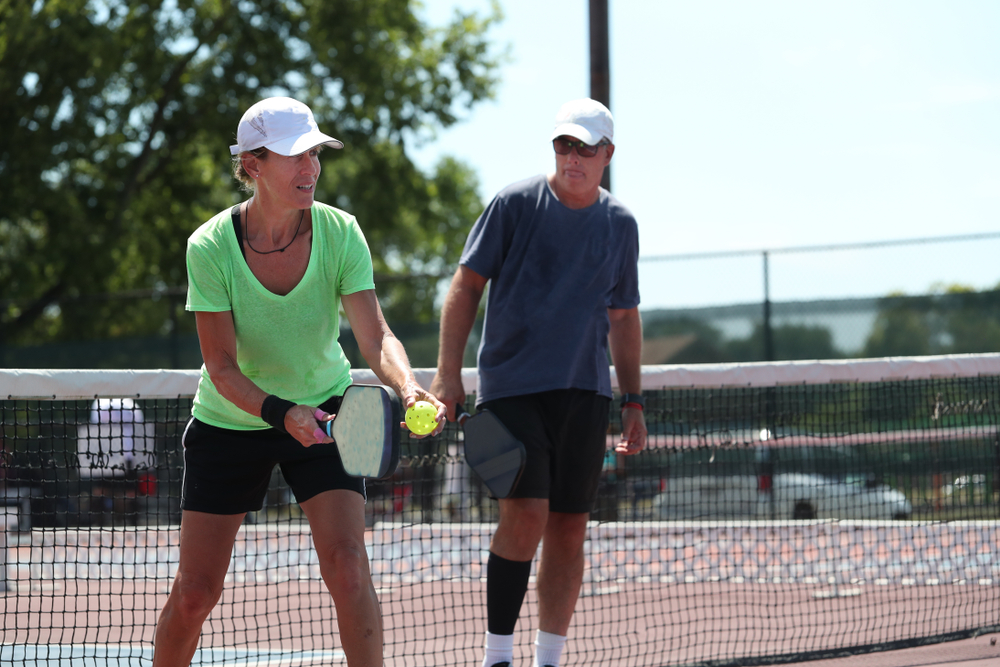Pickleball is a relatively new sport with a growing player base in the U.S. and around the world. Like many racket sport variants, only the serving side can score. So you should pay special attention to your Pickleball serve and try to make the most of the opportunity. This guide will take you through the rules of serving in Pickleball and give you some handy tips and tricks to get an edge on your opponents.
Rules of Serving
There a few core way that Pickleball serving is differentiated from other racket spots, and we’ll go over them here. You can find the full rules of Pickleball on the official website.
Rule #1: Underhanded Serves
The first rule to serving in Pickleball is that all serves must be underhanded. This lessening in intensity makes serving in Pickleball more of an opening gesture. It doesn’t mean you can’t score with a good serve however. An analogy could be drawn to chess. In the beginning there is a development of pieces. Rarely does the opening lead to immediate checkmate within the first few moves, but you can set up a decisive advantage.
Rule #2: The Paddle Must Contact the Ball Below the Waist
This second rule tries to reduce any improper angling on the behalf of the server. As per the rules, the paddle is meant to contact the ball below waist level or the navel.
Rule #3: Your Feet Must Stay Behind the Baseline
The server’s feet must not touch and traverse into the court until after the serve is made. When serving, consider yourself in a squared off space outside the court. Remember you are serving diagonally, so you may not pass the center line. You may not pass the sideline as well (although you usually would not even want to).
Other Rules to Know
There is only one serve attempt at a time – with the exception of a let. A let is when the ball hits the top of the net but still ends up on the other side of the court.
Another is serving the ball at any boundary line while you are serving is fine as long as you don’t hit any lines bordering the kitchen or within the kitchen itself.
The kitchen is the rectangular boundary close to the net. In this, volleys are not permitted during serves or in the game. The ball can only hit the kitchen in a strike that is not a serve or the strike returning a serve.
You must have one foot on the ground during serves. This is to prevent jumping serves and other advantages.
If you miss the ball when you are serving then it is a fault, but if you do not attempt to hit the ball then you are given another serve.
And the last rule is your serve may not come in contact with your partner in any way.
Serving Etiquette
There are a couple of things that you should know beforehand about etiquette.
Firstly, do not be surprised to find that some Pickleball players have a regimen or routine before they serve. It is not that Pickleball players are a particularly superstitious bunch. It is just a part of their game. You may want to consider a prayer or movement before you serve to build up confidence. A little swagger can go a long way.
After deciding upon the ritual, the next etiquette in Pickleball serving is calling out the score. While points can easily get stacked on either side and forgotten, calling out the score allows a steady reminder of the score for each side.
How to Serve
Here are some basic tips to get you started on serving.
1. Use Your Dominant Hand
Hold the ball in your weaker hand. Keep in mind that you will want to plant the opposite leg of your serving hand. So if you serve with the right hand, you will plant with the left leg.
2. Conduct Your ritual.
This part is meant to psyche you up for your serve and the game ahead. If you do not have a conscious mental ritual for yourself, then mentally prepare yourself for the serve.
3. Visualize Your Target
As a beginner you probably should not worry about strategy too much. A great starting tip is to visualize where you want the ball to go as you hit it. Remember, it can hit any of the boundary lines on the court except the kitchen boundary.
4. Call Out the Score and Serve!
Relax when you swing. This should allow for the ball to follow through more efficiently. Also, beginners should not worry too much about the tactics and strategy of serving. What is most important is hitting the ball and getting it into the opponent’s court. Then, you should stay back and see where the ball lands.
Remember, rules state that the ball has to bounce two times before you can strike volleys. It should bounce once in the opponent’s court after the service, then once in your court after their first strike.
Serving Tips and Tricks
Here are some tips and tricks to maximize your service game in Pickleball.
Practice, Practice, Practice
First, practice your serves. You will want to get a feel for how the ball hits the paddle before you start. How to plant which leg and keeping your swing below the navel are the building blocks of a good serve.
Finding a partner to help return serves, gives you good feedback as to how your serves are landing. Are they difficult for who you are playing against? Whether or not you can get a returning partner is fine, but practicing serves will give you an edge over other beginners.
Aim for the Back
Next, try to aim for the back of the court. A nice strong serve towards the back of the court makes it more difficult to return, and thus it gives you a better chance to score or create a favorable second strike. Just remember, you want your opponent responding to you and not the other way around.
How to Swing
Use your whole body when you serve. Remember to ground the opposite leg of your serving hand. This will give your serving swing more power as opposed to just using your arms. Also, according to Jordan Briones from PrimeTime Pickleball, you will want to use a closed stance. So, as opposed to facing the net, you are more facing the opposite sideline.
Also, when you bring your paddle back to serve, you do not want to pull your paddle back too far. Instead you want to pull it back at around waist level. Correspondingly you want the ball to be at about waist level when you drop it. Dropping it any higher or lower will distort the control you have on the serve.
Stay Back
Even if you hit the ball towards the back of the court, remember to stay towards the back of your own court so you can see where the returning strike lands.
Observe
Lastly, you will want to aim for your opponent’s weak side. Notice your opponent. What hand are they using to paddle? Are they weak on one side more than the other? What sort of areas do they like to strike to? How do they prefer to strike? Keep these things in mind and aim your serve in such a way to cause them maximum discomfort.
Serving Strategy
Most strategic players will vary the types of serves that they use in their repertoire and assign them to use against various players differently. Some players are more apt at returning various serves than others. For instance younger players are more prone to run around the court than older players. Changing the style and frequency of certain serves may lead you to acing your opponent (a serve that is rewarded a point due to the opponent’s inability to return). But do not worry too much about trying to acquire aces on your first rodeo.
What will help beginning players in serving is listening to the opponents playing style. Seeing which places players are softer at returning may help beginning players adapt to the game. Also, knowing your own strengths will help to design your second strike.
Types of Serves

Know you know some serving basics, here are some types of serve you can experiment with to get your pickle rallies off to a good start.
High Soft Serve
A high soft serve is just as it sounds. A simple serve coming in high from the net to the deep of the court. It is particularly effective at keeping your opponent in the back of the court. It is a good stable serve that does not take much energy to serve, but it does take a lot of energy from your opponent if they want to take over the momentum.
Power Serve
A power serve has a low trajectory directly after it has cleared the net. Due to the sheer power and aim behind the serve, returning the power serve can prove difficult even among skilled players.
Although it is more difficult to clear from the opposing side of the net in comparison to a traditional serve, it may not always be a great choice to open with. The power serve often comes to be more manageable once a player is expecting it, and it’s the element of surprise that gives it effectiveness.
Peppering in power serves into the mix with traditional serves may prove more successful for beginning players.
Topspin Serve
The tops spin serve is achieved by tilting your paddle with its face upward. Executing a topspin well causes the ball to bounce low and fast in a way that is difficult and awkward to return.
Again, this serve, mixed in with a repertoire of diverse serves, may prove especially difficult to return. This spinning factor, combined with aiming towards your opponent’s weaker areas, may add to your game greatly.
Soft Angle Serve
A soft angle serve traditionally comes in soft but low at an angle just after the kitchen line towards the edge of the court. In this way the ball is going towards the sidelines after the first bounce. This is a good serve to keep your opponent on their toes, but not good if they are expecting it.
Changeup Serve
The changeup serve is one that is different from what is habitually served. For example, if for most of the beginning of the game you serve at a regular pace, you could change to a softer pace aiming at just past the kitchen rather than the backline. This typically leads to some confusion in your opponent, leaving them to scramble in confusion towards the ball.
Changeups may take some time to set up, but when executed correctly they could lead to an ace or set you up for a scoring round. They also lend a psychological component to your game that will leave your opponent thinking, “Is he setting me up for a Changeup or something else?” that may distract them from returning optimally.
Ace!
Advanced players will have a lot of this under their belt already and know the texture and importance of the service game and the effect it has on the overall result.
But as a beginner, do not worry too much about mastering the techniques of different serves from the start. Get on the court with these beginner tips in mind and start practicing and building your repertoire of awesome starting serves.
